What is the role of a product manager in The Aha! Framework?
Last updated: April 2025
"Designed for product teams, by product teams." If we were to give The Aha! Framework for product development a tagline, this would certainly be a contender.
The Aha! Framework is different from other product development methods in a few ways. It suggests prescribed biannual strategic planning while supporting ongoing sprints with continuous deployment. But perhaps most importantly (at least for the purpose of this guide), The Aha! Framework was created by product development experts for fellow product teams.
The framework is informed by the Aha! team's decades of experience building successful products and working with thousands of product development folks. It is the engine that has powered our company's growth, and it is core to our position as the market leader for product development software.
You might be exploring The Aha! Framework for the first time. Or, you might be stepping into a product management role at an organization that already follows pieces of it. This guide provides an overview of best practices for product managers in either scenario. Keep on reading, or use the following links to jump ahead:
How product management fits into The Aha! Framework
Unlike other approaches that focus primarily on the "build" phase, The Aha! Framework takes the entire product development process into consideration. It is focused on the core activities needed to successfully deliver value rather than rigid workflow processes.
This holistic view of product development makes product management essential within the framework. Even the way the activities are described in The Aha! Framework makes it clear that product management is the nucleus of any organization's product development function.
Many product development teams toil in frustration because they are confined by methodologies that prioritize how work gets done. You end up spending more time trying to remember trademarked terminology, staying up to date with expensive certifications, and scheduling endless meetings than you do on actual product development — all so you can follow the process.
The Aha! Framework prioritizes why you do that work in the first place. The intention is not to put product management on a pedestal. It is to put the emphasis on value delivery over process pedantry.
Related:
Responsibilities of a product manager in The Aha! Framework
We might be a little biased, but we think being a product manager is the best job in the world. It is a dynamic and challenging role that will push you to learn and grow at every stage of your career.
Product managers are responsible for what gets built. That responsibility extends from setting the strategic vision for your product to measuring the realized value of what you prioritized. You also have those responsibilities without holding explicit authority over the folks who work alongside you to create that value.

The Aha! Framework is organized around the core stages of product development. There are activities within each stage where product managers complete discrete action items to further positive progress.
In our detailed guide about the activities, we suggest how often each of the activities should take place — but many occur concurrently and are ongoing depending upon how often you release new functionality.
The table below offers a checklist for product managers who follow The Aha! Framework. If it looks like a lot to do, well … that is because it is. Value-based product development is a real commitment. But remember: For a product manager, some of the activities are more about coordination and monitoring than performing the associated task.
For example, you are responsible for new functionality that is developed. But product managers do not actually write code. So in the build stage, you partner closely with engineering leads to ensure teammates have the information they need to deliver what customers will love.
As you go through the checklist below, make note of the folks in your organization you will partner with to complete each phase.
The Aha! Framework: Checklist for product managers | |
Stage 1: Strategize | □ Define product vision □ Review market conditions □ Draft product goals □ Identify key product initiatives □ Gather stakeholder feedback □ Set product strategy |
Stage 2: Discover | □ Define research goals □ Establish a participant research database □ Conduct customer interviews □ Analyze transcripts □ Connect insights to the roadmap |
Stage 3: Capture | □ Review customer feedback □ Review colleague feedback |
Stage 4: Explore | □ Whiteboard new user experiences □ Gather stakeholder feedback □ Update wireframes |
Stage 5: Plan | □ Update draft roadmap |
Stage 6: Showcase | □ Complete roadmap |
Stage 7: Build | □ Focus on high-priority features □ Complete designs □ Gather team and stakeholder feedback □ Update Minimum Lovable Product requirements □ Develop functionality □ Confirm built as designed □ Communicate progress |
Stage 8: Document | |
Stage 9: Launch | □ Announce new functionality |
Stage 10: Analyze | □ Improve overall process |
Product development team roles in The Aha! Framework
Many product development methodologies include a defined team structure. Scrum and the Scaled Agile Framework® (SAFe®), for example, both outline exactly how to organize teams and detail specific role titles (and descriptions) that must be active in order to fully follow each method.
The Aha! Framework does not demand any certain team structure. It does assume that there is a core product development team with representatives from key groups and a broader cross-functional team that supports ongoing product success.
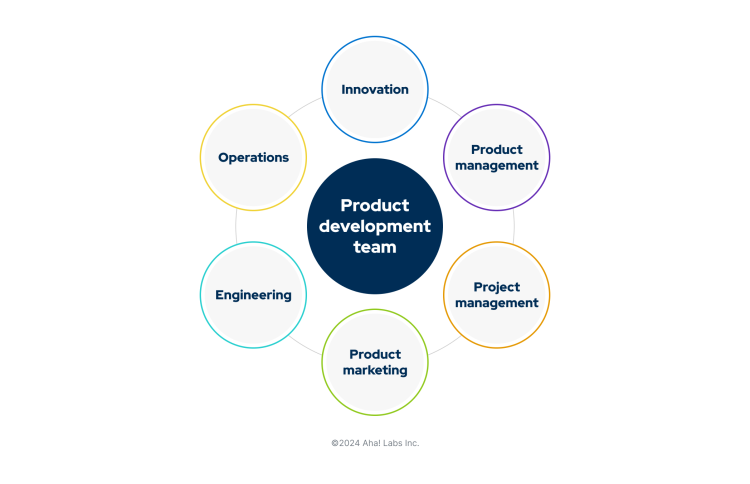
The core product development team typically includes innovation, product management and user experience (UX), project management, product marketing, engineering, and operations functions.
Depending on the size and maturity of your organization, you might have people who are dedicated to specific functions. Or you might have an individual who performs the work of several functions. In some companies, for instance, product management absorbs innovation, project management, and operational duties.
Related:
The broader product team includes representatives from cross-functional teams such as customer support, marketing, and sales. Although these folks are not involved directly in day-to-day product development work, they bring valuable perspectives about the market and customer needs that can inform your product plans. Do not shy away from their input and feedback.
The Aha! Framework hinges upon close collaboration among members of the core product development team. If functional groups are siloed, the burden falls to the product manager to foster team-building and knowledge sharing. Ultimately, the team's failure or success is your own failure or success.
As you review the responsibilities below, consider your product development team's strengths and weaknesses in each functional area. There are likely areas where you can immediately begin making improvements.
The Aha! Framework: Product development team responsibilities | |
Innovation |
|
Product management and UX |
|
Project management |
|
Product marketing |
|
Engineering |
|
Operations |
|
Templates for following The Aha! Framework
For product managers who use Aha! Roadmaps, we provide a template for The Aha! Framework that you can explore and customize on a digital whiteboard. We also have related templates for the various activities within the framework.

All of the templates below are available in Aha! software. We have provided one template for each stage as a jumping-off point. (You can explore the full scope of what we offer in our template library.) If you are already an Aha! customer, you can always reach out to our Product Success team for support implementing these templates.
The Aha! software suite includes everything needed to set strategy and build the roadmap, conduct customer research, crowdsource ideas, collaborate on whiteboards, streamline development, and centralize team documentation. You can experience the full suite with a free 30-day trial.
Stage 1: Strategize | Product vision template
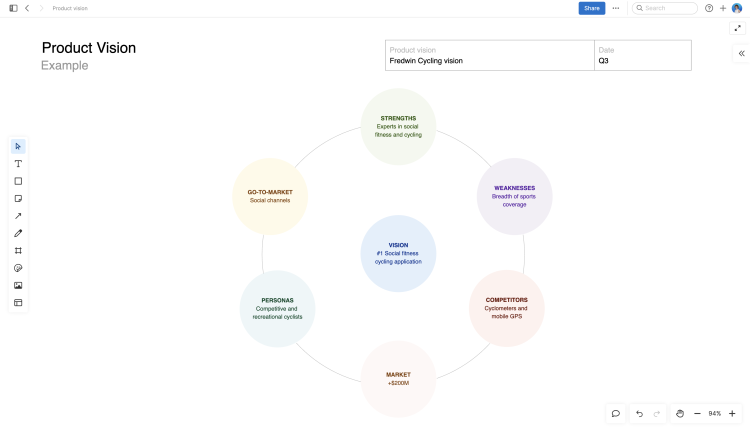
Stage 2: Discover | Customer research plan template

Stage 3: Capture | Ideas portal guide template
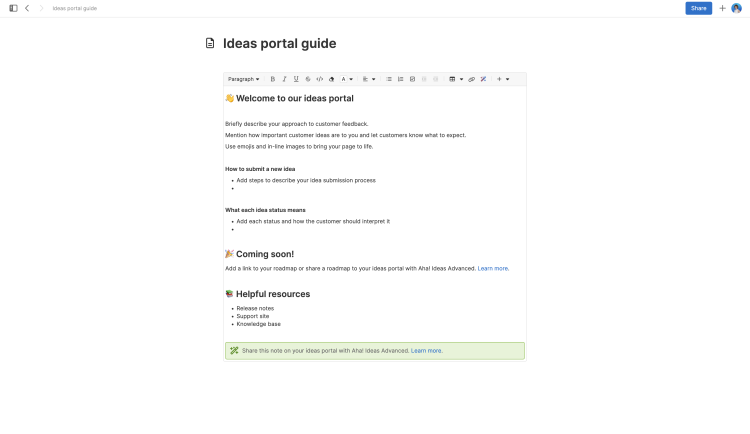
Stage 4: Explore | Brainstorming session template

Stage 7: Build | Feature requirement template
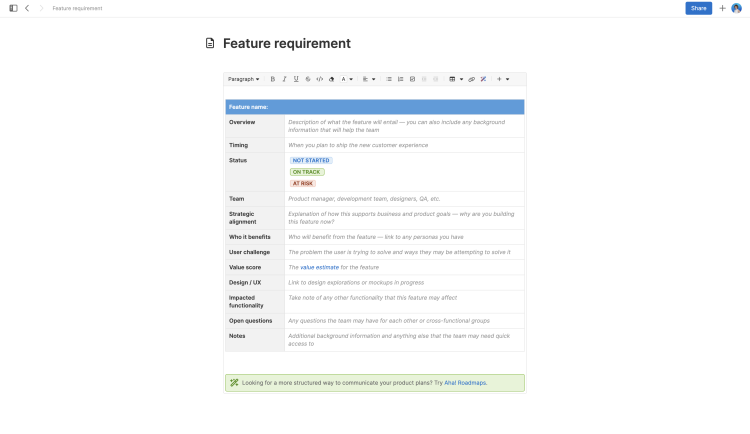
Stage 8: Document | Knowledge base article template
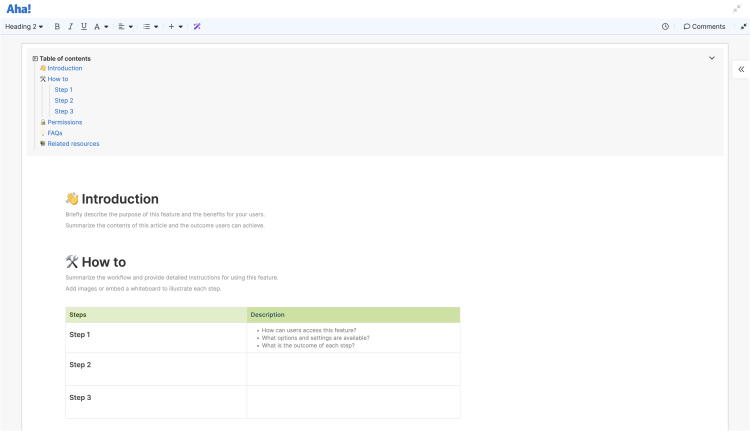
Stage 9: Launch | Product launch plan template

Stage 10: Analyze | OKRs template

With The Aha! Framework, product management shifts from simply moving tasks along to delivering sustained value. Product managers using this approach help teams stay centered on purpose — so every product decision counts. It is a practical way to build alignment, keeping everyone focused on what truly matters to customers and the business.




